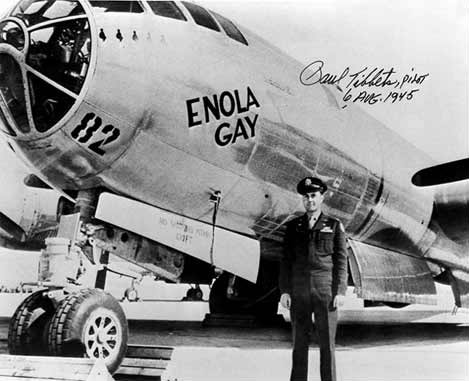B-29s BOMB JAPAN DAYS AFTER
THE TWO ATOMIC
BOMBS WERE DROPPED - Page 1
THE LAST RAID OF WW11, B-29s BOMBED THE AKITA OIL REFINERY.
JAPAN FAILED TO SURRENDER
Most Americans to this day are unfamiliar with the fact that one of the most potentially disastrous events occurred after the bombs were dropped on Hiroshima and Nagasaki. On August 6, 1945, the B-29 Enola Gay dropped the first Atomic Bomb on Hiroshima. The Japanese were warned that if they did not surrender further destruction would occur. When there was no reply from the Japanese three days later the B-29 Bocks Car dropped another bomb on Nagasaki. Still no reply. They were warned again of more bombings but failed to reply. The patience of the United States and President Truman was being pushed to the limit. Truman held many meetings with top military leaders to decide on when to drop the next bomb, this time on Tokyo.

PAUL TIBBETS AND ENOLA GAY
USAF
During all this time the U.S. insisted on unconditional surrender, with
Americans controlling Japan. Most of Japan’s military agreed they
would rather die fighting than to surrender. This thinking was in line
with the Bushido code of honor. Had the Japanese decided to continue the
war it could have cost millions of lives. Two ominous things were happening
at the same time. A large B-29 raid was scheduled
To destroy the last remaining oil refinery in Akita, Japan. At the same
time was a serious planned coup to stop the Emperor from surrendering.
The U.S. faced an enormous problem, especially since they had no idea
of the overthrow plan. After nearly burning every city in Japan to the
ground with the disastrous fire bombing with Napalm, and then the two
horrible Atomic attacks destroying two cities, the U.S. had waited long
enough. There were also other problems looming, the Russians were approaching
Japan from the North. The U. S. did not want the Russians to “share”
in this victory, which would end up dividing Japan. Truman gave the order
“Give em everything you’ve got.”

BOEING B-29 SUPERFORTRESS
USAF
REMEMBERING OKINAWA
The battle of Okinawa caused the U.S. to reconsider a direct assault on Japan. The Japanese had shown such a fanatical resistance, with every man fighting to his death. Once again, death was not feared, but considered honorable. Besides having a two million man well trained army, there were perhaps thousands of Kamikaze planes with thousands of volunteer pilots, ready to defend the Island to their death. With all the intense preparations, both countries had to make a decision. With the question of possibly millions of deaths, two major happenings were progressing at a rapid rate. Most Americans are unaware that even after two A-Bombs were dropped, B-29s continued their relentless pounding of major targets. The 315th Bomb Wing at Guam was ordered to bomb the last oil refinery at Akita. It would be the longest mission of the war. To reduce weight planes were stripped of all guns except the tail guns. Planes carried only 10 man crews. The 315th would send 143 aircraft to destroy Japans much needed, last refinery. Engines were cranked up and were ready to taxi for take off when notified to stand down as the U.S. had received information that the Japanese had made the decision to accept the Potsdam Declaration, thereby ending the war. The U.S. waited nearly an hour, then ordered the mission to proceed. The 315th took off one hour ahead of the other bomb wings. Of the 143 planes that took off 15 had to turn back due to various mechanical problems. The B-29s were on there way to Akita.

PHOTO: B-29 LOADING UP
USAF